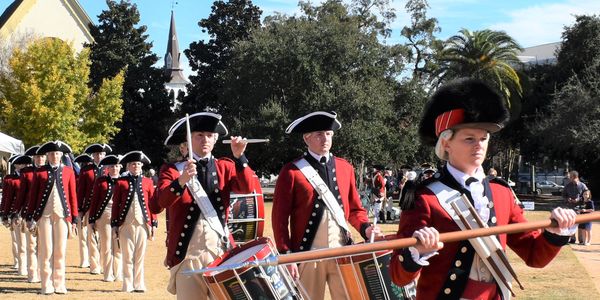June 1776-The War For American Independence Begins
The British Empire Strikes America
50 British ships, over 300 cannon, 10,000 stands of arms, over 3,000 professional troops under Generals Clinton and Cornwallis attack America at the mouth of Charlestown harbor after a four-week warship blockade and troop build-up. The British objective: capture Charlestown, then the Carolinas and Georgia, recruit and arm Loyalists and Native Americas, make Charlestown "the seat of the war" to conquer America.
One of the largest amphibious assaults of the time commences.

From Rebellion to Revolution to Quest for Independence
The British blockade and troop landings climax with Sir Peter Parker's direct attack on Fort Sullivan on June 28th ("Carolina Day") with Britain's finest warships and crews. Parker's armada is soundly defeated in an all-day cannon duel directed by Patriot Colonel William Moultrie at Fort Sullivan's palmetto log fort. Generals Clinton and Cornwallis prized regiments fail in multiple attacks on Continental and allied militia troops entrenched at Fort Thompson, protecting Fort Sullivan's landward backside.
As the British Army and Navy Retreat the Spirit of '76 ignites into A National Bonfire
All 13 Colonies have their representatives sign the Declaration of Independence on August 2, 1776 - one month after Continental and allied militia forces win the First Battle for Charlestown. America has proven they can stand up and win against the "finest army and navy in the world". Independence fever breaks out into a national "glorious cause" for self-government by the people.
The signed Declaration is subsequently sent to King George III and newspapers throughout Europe asserting the Colonies' political and economic independence; and an elected government dedicated to ensuring the inalienable rights of "Life, Liberty, and the Pursuit of Happiness" for citizens of the "united States of America".
"...rebellion would have never turned into Revolution ..."

Containing the British on Long Island (Isle of Palms)
Holding Fort Sullivan and stopping the British Fleet from gaining the harbor
Repelling Repeated British Amphibious Landings on Sullivan's Island
Visit Fort Thompson on Sullivan's Island at Breach Inlet and envision "Colonel 'Danger" Thompson's men, Catawba Patriots', and Virginia Continental's gallant stand to stop Britain's finest army from capturing Fort Sullivan and Charlestown.

Repelling Repeated British Amphibious Landings on Sullivan's Island
Holding Fort Sullivan and stopping the British Fleet from gaining the harbor
Repelling Repeated British Amphibious Landings on Sullivan's Island
A month long British siege with constant probing attacks. Their last gasps to cross the Inlet and land on Sullivan's Island defeated by the united Continental and Militia Patriots from across the Colonies.

Holding Fort Sullivan and stopping the British Fleet from gaining the harbor
Holding Fort Sullivan and stopping the British Fleet from gaining the harbor
Holding Fort Sullivan and stopping the British Fleet from gaining the harbor
The Battle for Charlestown climaxes with an all-day cannon duel between the Patriots at Fort Sullivan and Sir Peter Parker's warships attempting to gain the harbor. The Patriots win, the South Carolina Royal Governor aboard the flagship is mortally wounded, and this battle becomes annually celebrated as "Carolina Day".
Charlestown Independence Trail
Revolutionary War Victory Museum
SC'S First Fallen National Memorial Wall - see editorial post and Courier, July 4, 2023